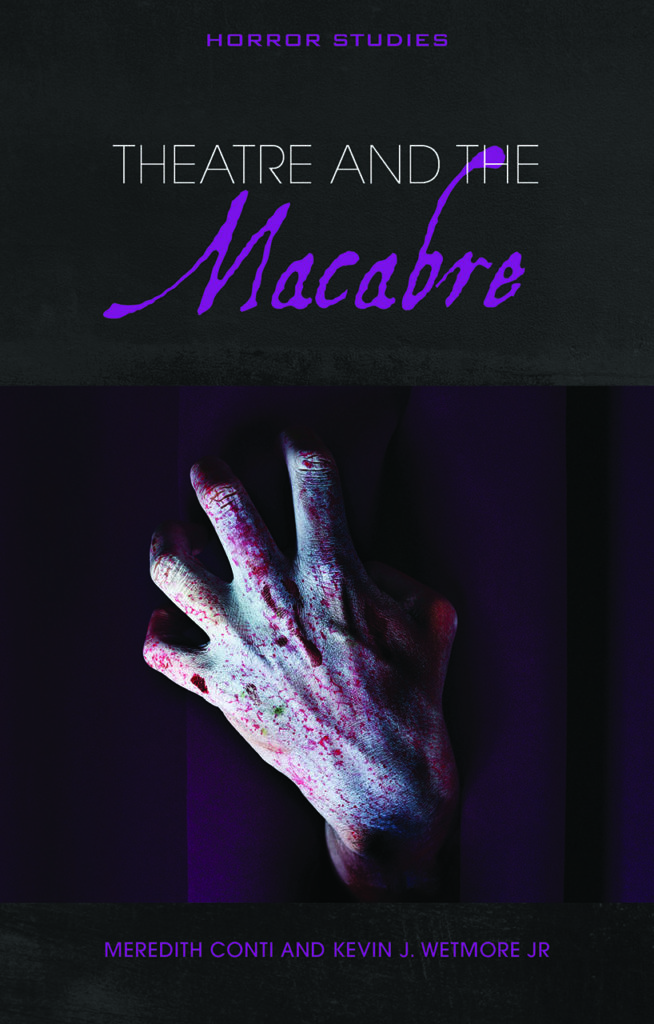Meredith Conti and Kevin J. Wetmore Jr. introduce their edited volume in our Horror Studies series, Theatre and the Macabre.

‘Le Respit de la Mort’, a 1376 poem by Jean le Fèvre, marks the first recorded use of the word macabre. ‘Je fis de macabre la dance’, the didactic poem declares, or ‘I made the dance of death’, a phrase some scholars believe le Fèvre wrote while recovering from the plague. Often in times of uncertainty, loss and fear, the culture places a focus on things macabre – reminders of death, dead bodies, and our own mortality. Nowhere is this sense of the macabre more clearly put on display than in the theatre, in which, from its very origins in the west in ancient Athens, tragedy focuses on death, loss, the destruction of the heroic body, and the lingering supernatural presences in the face of these elements (see The Oresteia, with its many murders, the monstrous Furies and the ghost of Clytemnestra, to consider how theatre is rooted in the macabre from its origins).
The ‘macabre’, as a process and product, has been haunting the theatre – and more broadly, performance – for thousands of years. In its embodied meditations on death and dying, its thematic and aesthetic grotesquerie, and its sensory-rich environments, macabre theatre invites artists and audiences to trace the stranger, darker contours of human existence. The very nature of the macabre allows it to traverse sites, mediums and genres, making the task of reckoning with ‘macabre performance’ well-suited to a multi-authored, multidisciplinary collection. Theatre and the Macabre is the first scholarly volume to theorise on and illuminate theatre’s intimate, productive and sometimes confounding relationship to the macabre. Across sixteen essays, scholars and practitioners of theatre, dance and performance studies scrutinise the texts, designs, choreographies, scores and habitats that create the macabre on stage. Together, these contributors argue that as something performed and witnessed, macabre theatre does not just frighten or entertain; its cultural work both encompasses and exceeds such spontaneous reactions. Indeed, macabre performances have the potential to speak deeply and provocatively to shared social, cultural and political anxieties.
From freak shows to the Grand Guignol, from butoh to immersive haunts and dark rides, from uncanny apparitions through gothic mothers to public execution, whether by hanging or decapitation, from Hell Houses to Ford’s Theatre, where Abraham Lincoln was assassinated, as tourist site – this volume’s essays interrogate the macabre in performance. In doing so, they reveal much about our attitudes towards death, but also, paradoxically, about our attitudes towards life. Take a dark ride through macabre theatre history and celebrate the dance of death.
Meredith Conti is Associate Professor of Theatre at the University at Buffalo, SUNY, and a historian of nineteenth-century performance and popular culture in the United States and Britain. She is the author of Playing Sick: Performances of Illness in the Age of Victorian Medicine (2018) and of published essays exploring the intersections of theatre and medicine, gender and race in the Victorian period, and gun violence in theatre.
Kevin J. Wetmore, Jr. is Professor of Theatre and director of the MFA program at Loyola Marymount University. He is the author, editor and co-editor of over two dozen books, including Post-9/11 Horror in American Cinema (2012), Eaters of the Dead: A Cultural History of Cannibal Monsters (2021), the Bram Stoker Award-nominated The Streaming of Hill House (2020), and numerous articles on horror theatre.


